Grow the right plants to attract more hummingbirds to your garden. Follow the design ideas in this garden plan to get a garden you’ll love just as much.
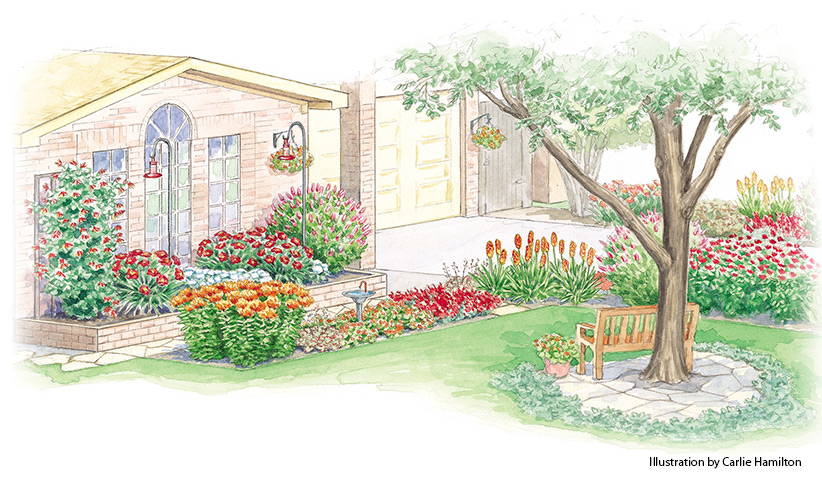
This beautiful garden plan is full of plants that are sure to attract more hummingbirds.
You don’t need a big garden to lure in hummingbirds — even a relatively small garden like this one will bring them in. They’re attracted to bright-colored flowers, so this garden includes lots, both in the ground and even in a hanging basket. The tree in the front yard is great for offering this sunny garden some cooling shade during the hottest part of the day. But the yard still gets plenty of sun to let these plants grow and bloom vigorously. Check out the details below to attract hummingbirds to your garden.
Include a variety of plants to attract more hummingbirds each season
This design includes nectar-rich flowers with different bloom times for a constant food supply. Starting in spring with the blooms of trumpet honeysuckle and pineleaf penstemon, to summer flowers of daylily, bee balm and red hot poker, right up until the last flowers of summersweet, there’s plenty for the birds to eat.
Remember to stay clear of insecticides and herbicides. You don’t want to poison your visitors as they eat treated insects. And systemic herbicides absorbed by the plant can also be present in the nectar the little birds feed on.
Plant large masses of flowers
A strong splash of color created by five to 10 plants together is much more visible to passing hummingbirds and improves the odds of attracting them to your garden. Chances are, once one visits, it’s more likely to return the following year — adding even more color to your garden!
Setup a view
A birdbath with a dripper in front of a window offers lots of entertainment. When pruning shrubs or trees, leave a few small bare branches or twigs on the plant. These are favorite hummingbird perches (and give you a clear view of the little birds).
Consider feeder placement
Two hummingbird feeders hang a few feet in front of the windows, where you can enjoy watching the birds. Position them with space between — these are 7 ft. apart — and higher than 6 ft. off the ground (to protect them from hungry cats). Place the posts close to the path to make cleaning and filling convenient. Use a mixture of one part white sugar to four parts water. Don’t use honey, brown sugar or artificial sweeteners, which aren’t good for the birds.
In northern climes leave feeders out two weeks after you’ve seen the last hummingbird in fall to feed any late-comers. Then clean and store them inside for the winter. In the South, leave feeders out all year.
Maintenance tips
In addition to having beautiful blooms, these plants are very easy care. Check out the tips below to keep this garden looking great.
- The main task is deadheading the faded blooms of the red hot poker, starflower and penstemon.
- And though it won’t promote more flowering, snap off the faded daylily blooms to tidy up the plant.
- Once the bee balm’s flowering finishes, if you spot powdery mildew, cut back the plant to about 6 inches tall or to the fresh foliage.
- ‘Ruby Spice’ summersweet’s casual-looking habit and fragrant blooms, like the other plants in this garden, will provide a lot of flower power without needing a lot of man (or woman) power.
- The nectar of butterfly weed attracts butterflies, as well as hummingbirds. Remove the seed pods if you don’t want it to reseed.
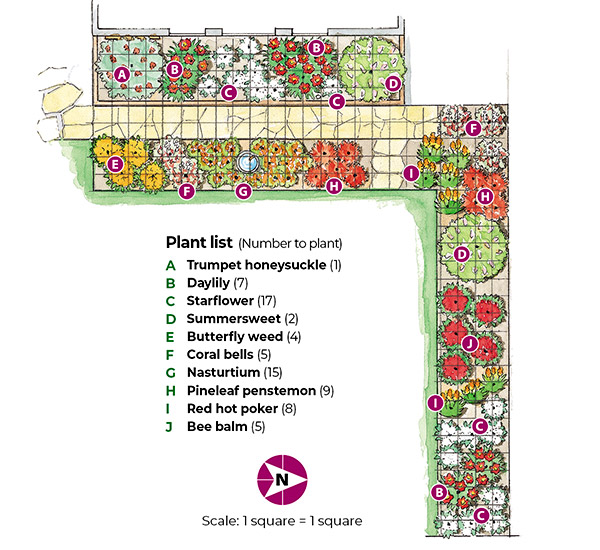
Overhead view of garden plan.
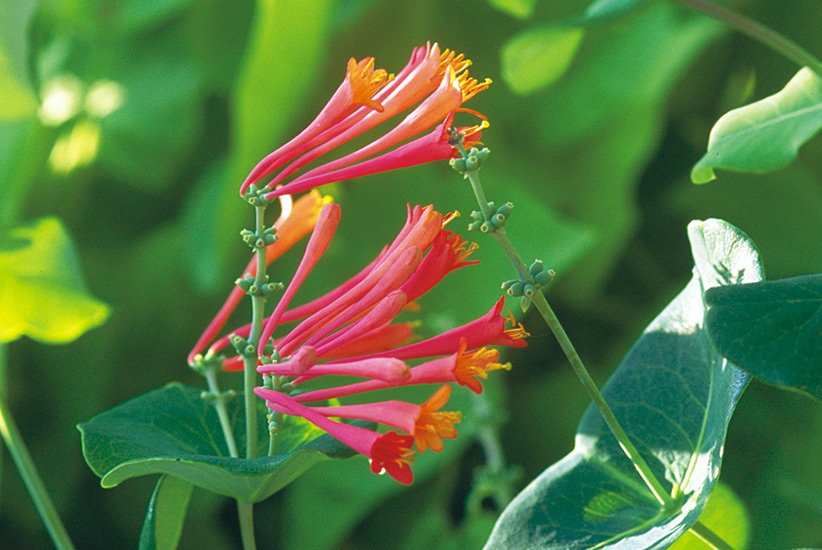
A. Trumpet honeysuckle (Lonicera sempervirens)
Type Perennial vine Blooms Very showy, long trumpet-shaped orange-red blooms in spring to summer; oval blue-green leaves; red berries in fall are attractive to birds Size 6 to 20 ft. tall, 3 to 5 ft. wide Light Full sun to part shade Hardiness Cold-hardy in USDA zones 4 to 9.

B. Daylily (Hemerocallis ‘Chicago Apache’)
Type Perennial Blooms Scarlet red blooms in summer; rabbit-resistant; divide clumps every three to four years for the most blooms Size 24 to 30 in. tall and wide Light Full sun to part shade Soil Moist, well-drained, but is tolerant of clay soil HardinessCold-hardy in USDA zones 3 to 9.
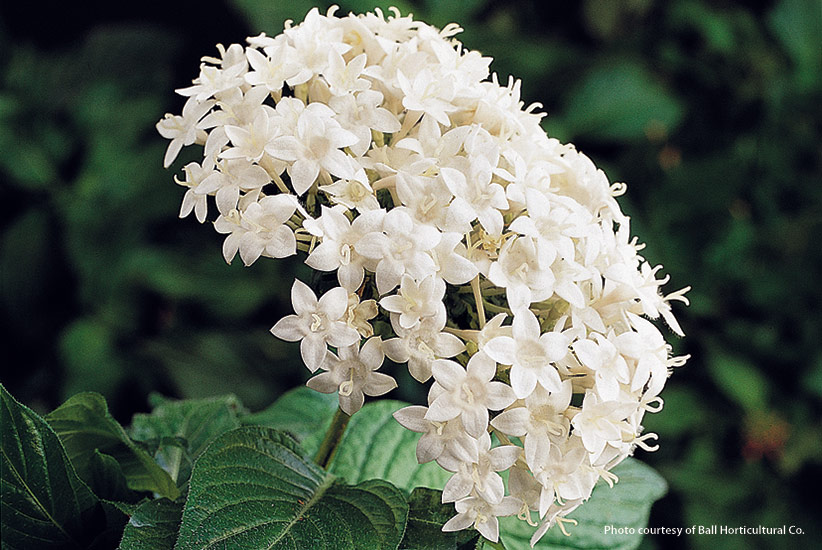
C. Starflower (Pentas lanceolata ‘Butterfly White’)
Type Tender perennial (Usually grown as an annual) Blooms White star-shaped blooms from summer to frost Size 12 to 22 in. tall, 10 to 18 in. wide Light Full sun Soil Moist, well-drained soil; very heat-tolerant with regular moisture Hardiness Cold-hardy in zones 10 to 11
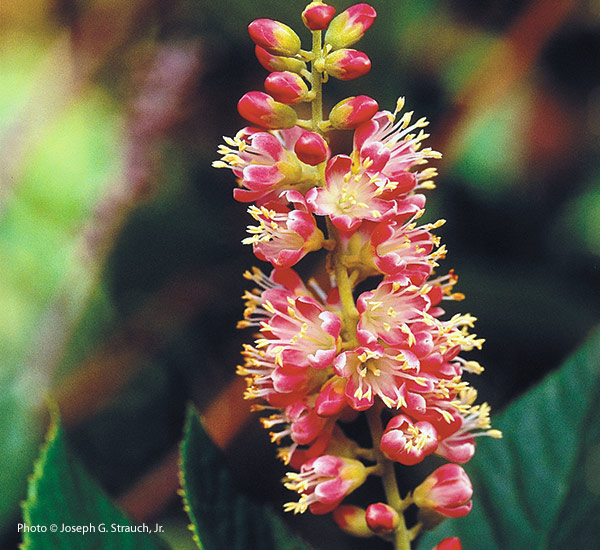
D. Summersweet (Clethra alnifolia ‘Ruby Spice’)
Type Shrub Blooms Fragrant pink blooms from summer to early fall; glossy green foliage turns yellow in fall Size 3 to 6 ft. tall, 3 to 5 ft. wide Light Full sun to part shade Soil Prefers moist, well-drained soil, but tolerates clay soils Hardiness Cold-hardy zones 3 to 9.
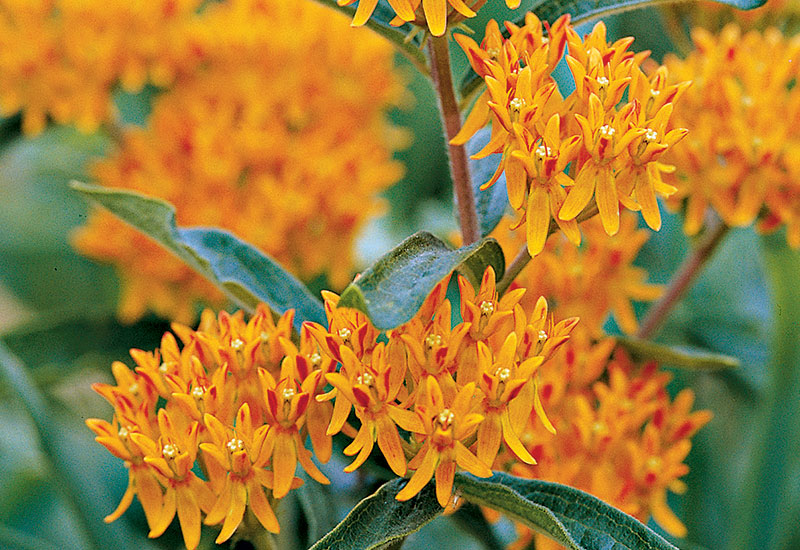
E. Butterfly weed (Asclepias tuberosa)
Type Perennial Blooms Orange summer flowers followed by attractive seed pods; reseeds; attractive to butterflies and hummingbirds Light Full sun to part shade Soil Well-drained Size 1 to 3 ft. tall , 1 to 2 ft. wide Hardiness Cold-hardy in USDA zones 3 to 9.

F. Coral bells (Heuchera ‘Purple Petticoats’)
Type Perennial Blooms Tan or cream flowers in late spring; frilly dark purple foliage, evergreen in warmer zones Size 12 to 18 in. tall, 18 to 24 in. wide Light Part shade Soil Moist, well-drained; apply a 2- to 3-in. layer of mulch after ground freezes to prevent roots from heaving Hardiness Cold-hardy in zones 4 to 9.

G. Nasturtium (Tropaeolum majus ‘Vesuvius’)
Type Annual Blooms Orange blooms from late spring to frost; medium green foliage Size 10 to 12 in. tall and wide Light Full sun to part shade Soil Does best in poor, infertile soil; keep moist during growing season.
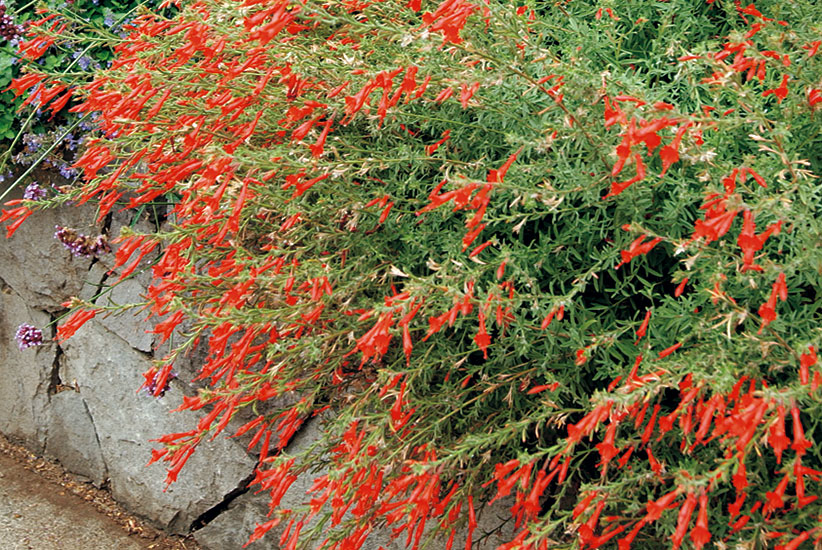
H. Pineleaf penstemon (Penstemon pinifolius)
Type Perennial Blooms Orange-red tubular blooms from late spring to summer; reseeds — deadhead the faded flowers if you don’t want lots of seedlings Size 12 to 15 in. tall, 15 to 18 in. wide Light Full sun to part shade Soil Well-drained soil and regular moisture Hardiness Cold-hardy in USDA zones 4 to 9.

I. Red hot poker (Kniphofia ‘Flamenco’)
Type Perennial Blooms Orange spikes in early to midsummer; cut faded flower spikes to encourage rebloom Size 30 to 36 in. tall, 15 to 18 in. wide Light Full sun to part shade Soil Rich, well-drained Hardiness Cold-hardy in USDA zones 5 to 9.

J. Bee balm (Monarda ‘Jacob Cline’)
Type Perennial Blooms Bright red flowers in summer; cut back after flowering finishes if mildew occurs; divide every two to three years in spring Size 3 to 4 ft. tall, 2 to 3 ft. wide Light Full sun to part shade Soil Moist, well-drained Hardiness Cold hardy in USDA zones 4 to 9.
BY GARDEN GATE STAFF | Octorber 7, 2019

Leave a comment